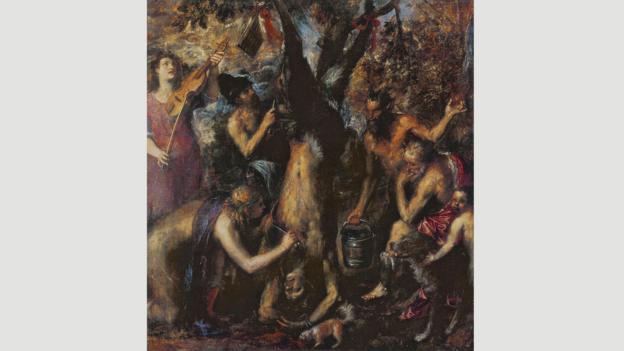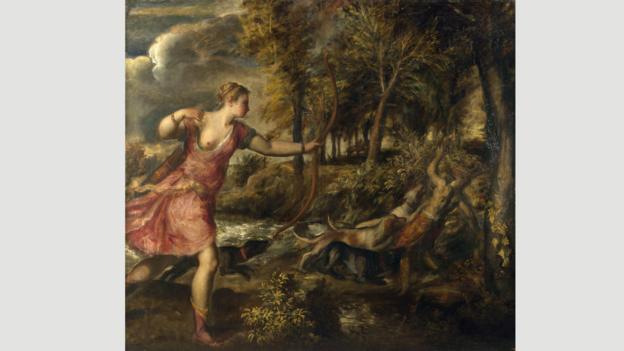It is one of the grisliest scenes in Western art: Marsyas, a satyr from Greek mythology, who rashly challenged the god Apollo to a musical contest and lost, is tethered, upside-down, to a tree, so that he can be flayed alive.
In fact, his horrible punishment has already started. One tormentor, Apollo himself, slices a blade into Marsyas’ torso, and bright, fresh blood, echoing the crimson bonds that lash his hooves to the branches above, drips down his arm into a pool beneath his head. A delighted lapdog licks at the puddle of sticky red. The satyr’s right eye, shiny with stunned terror, stares out at the viewer.
Did Titian want two styles – the meticulous versus the carefree – to coexist within the same image?
This gruesome masterpiece is The Flaying of Marsyas. It was painted, probably during the 1570's, by the great genius of 16th Century Venetian painting, Titian. Today it hangs in the former archbishop’s palace in Kroměříž, in the Czech Republic. Until a few decades ago, it was relatively little-known – but ever since it started reaching a wider audience, The Flaying of Marsyas has presented art historians with a conundrum. For, like a number of other works from Titian’s final decade (he died in 1576), it is not clear whether it is finished.
Certain passages of the painting, such as Marsyas’s eye, Apollo’s wreath, or the crown worn by King Midas (a self-portrait?), who looks on plaintively, appear refined and perfectly resolved. There is even what could be Titian’s own signature on a rock in the foreground.
And yet other areas of the canvas, such as the sky and foliage behind, are remarkably broad and free. Did Titian want two styles – the meticulous versus the carefree – to coexist within the same image? Or, despite the signature, did he simply never get around to completing his composition?
We will probably never know the truth. But this is what makes The Flaying of Marsyas such an intriguing highlight ofUnfinished: Thoughts Left Visible, a major new exhibition, featuring more than 190 artworks from the Renaissance to the present day, which is inaugurating the Met Breuer, the temporary expansion of New York’s Metropolitan Museum of Art into Marcel Breuer’s famous modernist building on the corner of Madison Avenue and 75th Street.
Incomplete thoughts
An unfinished picture is almost like an X-ray, which allows you to see beyond the surface of the painting – Kelly Baum
Broadly speaking, the exhibition argues that there are two sorts of unfinished artworks. The first category comprises paintings or sculptures which, for whatever reason, were simply never completed. Perhaps the death of the artist interrupted, or a commission lapsed. Unfinished compositions of this sort (there are 45 examples in the Met Breuer show) can be extremely valuable for art historians because, in the words of Kelly Baum, one of the exhibition’s curators, “An unfinished picture is almost like an X-ray, which allows you to see beyond the surface of the painting to what lies behind: earlier versions, preparatory sketches, all of the underlying architecture which is normally disguised and suppressed. And this gives profound insight into the creative process.”
A classic example of this – which, incidentally, will not be part of the Met Breuer exhibition – is the so-called ‘Manchester Madonna’, painted in the late 1490s by the young Michelangelo, and now in the National Gallery in London. This tempera-on-poplar panel reveals much about Michelangelo’s decision-making. We see that he liked to work up individual figures in his compositions one by one: there is a marked contrast between the relatively finished characters to the right and the incomplete male youths to the left. We also learn how Renaissance artists went about the technical side of their business: Michelangelo used a green pigment, or terra verde, as his base tone for flesh.
Yet, according to the Met Breuer show, there is also a second important category of unfinished artworks: those that only seem unfinished, but which their artists actually deemed complete, because they were striving, intentionally, for an unresolved aesthetic. Well-known examples would include everything from late Turner and Rodin to the work of the Impressionists or 20th Century artists such as Jackson Pollock and Robert Rauschenberg. And Titian’s Flaying of Marsyas may provide an early, and definitive, instance of this artistic delight in open-endedness.
Fill in the blanks
During the 16th Century, thanks, in part, to the infamous precedents of Leonardo da Vinci and Michelangelo, who both left so many works of art incomplete, it became fashionable for artists to try to achieve unfinished effects. There is even an Italian term for this style: non finito.
Titian seems to have drawn upon this concept when forging his own distinctive aesthetic towards the end of his life. The Flaying of Marsyas isn’t the only one of his late paintings that appears unfinished. For instance, The Death of Actaeon, in the National Gallery, is also characterised by remarkably loose, almost expressionistic brushwork.
If you’re good enough, then just suggesting can be enough – George Condo
It offers another horrific scene, in which the hunter Actaeon is punished for stumbling across the goddess Diana naked, by being turned into a stag and mauled by his own hounds. The paintwork is so swift that, in an extraordinary way, it enhances the overall atmosphere of the painting, because the leaves of the wood in which the action takes place appear to vibrate and rustle before our eyes.
“It’s almost as if the dying leaves of the woods – all these rusted tones – have blown up to create this image,” the American painter George Condo once told me, while standing in front of the canvas. “The painting may not have been finished – some of the passages are so suggestive. But that’s inspirational to painters, because it shows that if you’re good enough, then just suggesting can be enough.”
Something similar happens in The Flaying of Marsyas. It seems likely that Titian used different registers of ‘finish’ within the painting to direct the viewer around the action, and emphasise the most important points, such as the telling psychological detail of the satyr’s terrified eye.
As Baum explains: “The unfinished style forces you as a viewer to engage with the painting in very palpable, visceral ways. A seemingly unfinished work of art demands your creative and imaginative investment in a picture, because you have literally to fill in the blanks. So, for works of art like Titian’s, which represent moments of real physical and psychological distress, we think that the emotional impact of the paintings was greater because of Titian’s use of a non finito style.”
Alastair Sooke is Art Critic of The Daily Telegraph.



No comments:
Post a Comment